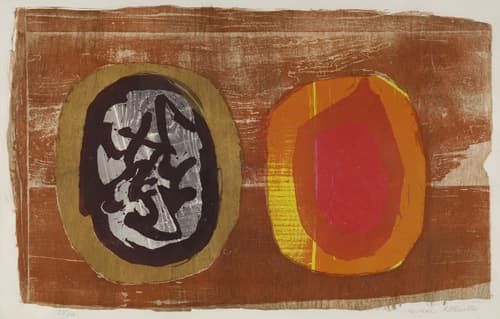
Michael Rothenstein – Red Jazz ‘196’
Statement
Throughout the 1980s Rothenstein displayed restless energy. The methods he used became more and more complex and the colours more and more fearless, using clashing reds and oranges. Colour came into its own, dominant and vocal. Images of that period can be compared to the artist’s early childhood drawings done at a time when he discovered his father’s collection of Rajput miniatures, brilliant images on Chinese vermillion background and festive colours.
This composition was made of plywood under ancient board taken from a building site and cut away to form two ovals with linocut elements. The construction was subsequently made into an assemblage box: Eight (Box 33).
Biography
Michael Rothenstein was born in London in 1908, the son of the artist Sir William Rothenstein (1872-1945). He studied at Chelsea Polytechnic and General School of Arts and Crafts from 1924 to 1927 and had his first one-man show at Matthiesen Gallery in London in 1938. During the Second World War he participated in the Pilgrim Trust Recording Britain project and made his first prints in 1946 for a first series of School Prints for use in schools, as a means of giving children an understanding of contemporary art. He also made drawings for the War Artists Committee. Between 1948 and 1953 he made further prints including works for the Miller’s Press in Lewes, Sussex. He also executed a large group of monotypes between 1948 and 1950 and after a series of short visits to S W Hayter’s Atelier 17 in Paris began making colour etchings. In the early 1950’s he exhibited both in Great Britain and abroad. It was in 1954 that he founded a graphic workshop in Great Bardfield in Essex, home of the artists Edward Bawden and John Aldridge and went on teaching at the Camberwell School of Art, having won first prize in the Giles Bequest Competition for colour woodcuts and linocuts in 1954 and 1956. His main contribution was the development of the relief print using found objects and materials, such as metal, plaster, fabric: anything that could be coated in ink. This became the subject of three of his books, including Frontiers of Printmaking (1966) and Relief Printing (1970). Rothenstein showed in many London Galleries and had a retrospective exhibition at Stoke-on-Trent City Museum and Art Galleries in 1989-90. The Tate Gallery, the V&A, the British Museum and the Museum of Modern Art in New York hold his work. He was made RE and elected RA in 1983. His daughter Anne is also a painter.
Bibliography
CHAMOT, Mary, FARR, Denis and BUTLIN, Martin, The Modern British Paintings, Drawings and Sculpture, London, 1964
PLATTE, Hans., Artists Prints in Colour, Barrie & Rockliff, London, 1961
REINER, Imre, Woodcut, Wood Engraving: A Contribution to the History of Art , Publix, London, 1947
ROTHENSTEIN, Michael, Frontiers of Printmaking: New Aspects of Relief Painting, Studio Vista, London, 1966
SIDEY, Tessa, The Prints of Michael Rothenstein, Scholar Press, Aldershot, 1993
Evelyne Bell





